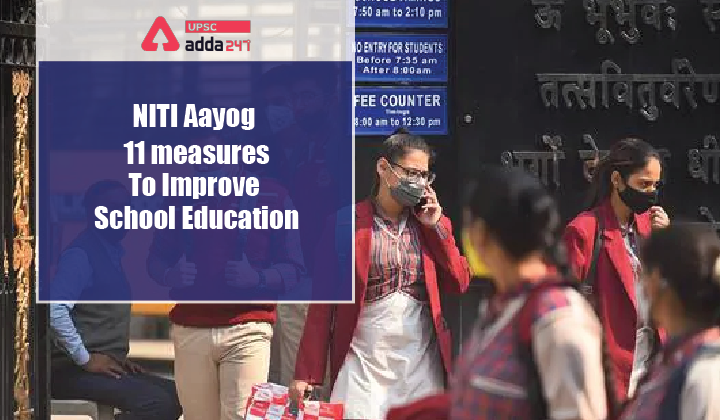Table of Contents
NITI Aayog Report: Relevance
- GS 2: Issues relating to development and management of Social Sector/Services relating to Health, Education, Human Resources.
NITI Aayog Report: Context
- NITI Aayog has recently suggested 11 measures to improve the country’s school education system, for effective implementation of National Education Policy, 2020.
NITI Aayog Report: Key points
- The suggestions largely were related to improving the learning outcomes.
- The recommendations were released as part of a report Systemic Transformation of School Education.
- They are based on findings of NITI Aayog’s Sustainable Action for Transforming Human Capital (SATH-Education) initiative.
- The steps undertaken by these states under SATH initiative resulted in an average 20% improvement in the education system in the past few years.
- The report highlighted that though Right to Education Act has ensured over 96% enrolment of students in age group 6-10 years, learning outcomes did not reflect the improved quality of education.
NITI Aayog Report: Suggested Measures
- School education, especially, the preschool level, should be more inclusive. In our school-level learning process, no one should be left behind or have disadvantage.
- The NITI Aayog Report 2021 proposed interventions in five key areas:
- focus on academic reforms,
- strengthening human capacity,
- strengthening administrative systems, driving accountability and
- creating a shared vision for change.
- States should prepare a Learning Outcome Framework (LOF) to resolve the gap between learning outcome and the GER issue.
- The report also highlighted the need to simplify the assessment process and the need for learning enhancement programmes.
- States need to implement remediation in campaign mode for 4-5 years to bring all children to grade-level.
About SATH-E
- Project SATH-E, ‘Sustainable Action for Transforming Human Capital-Education’, was launched in 2017 to identify and build three ‘role model’ States for the school education sector.
- After an elaborate selection process, Jharkhand, Odisha and Madhya Pradesh were chosen.
- The first phase of SATH-E was completed in March 2020.
SATH-E achievements
- Learning enhancement programme/remedial teaching with workbook support for approximately 2.3 crore students implemented.
- Academic monitoring of schools and students streamlined, with nearly 1.5 lakh inspections carried out every month.
- Comprehensive rewards and recognition programmes, including external certifications, initiated.
- Assessment reforms, including spot testing and learning tracking formats, introduced.
- Multiple rounds of teacher training
- In Madhya Pradesh, 30% of the students moved from lower-level foundational literacy, numeracy learning cohorts to the highest learning level for grades 3–8 in two years of the ‘Dakshta Unnayan’ learning enhancement programme.
- In Odisha, average improvement of 10–15% observed in learning outcomes due to the ‘Ujjwal-Utthan’ learning enhancement programme.
- In Jharkhand, 12% improvement across most competencies was recorded through the ‘Gyan Setu’ learning enhancement programme.
- With the onset of the Covid-19 pandemic, SATH-E adapted itself as ‘Digi-SATH’ to provide undeterred support via digital mediums.
- Under the Digi-SATH initiative, MP’s ‘Hamara Ghar Hamara Vidyalaya’ and ‘Digi-LEP’ (or ‘Digital Learning Enhancement Programme’), Odisha’s ‘Shiksha Sanjog’ and ‘Shiksha Sampark’, and Jharkhand’s ‘Hamara Doordarshan Hamara Vidyalaya’ have been providing online education and teacher training.



 TSPSC Group 1 Question Paper 2024, Downl...
TSPSC Group 1 Question Paper 2024, Downl...
 TSPSC Group 1 Answer key 2024 Out, Downl...
TSPSC Group 1 Answer key 2024 Out, Downl...
 UPSC Prelims 2024 Question Paper, Downlo...
UPSC Prelims 2024 Question Paper, Downlo...





